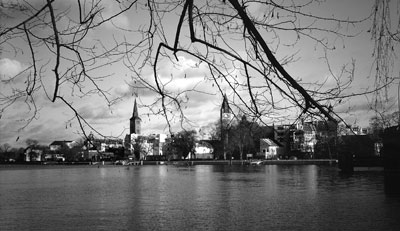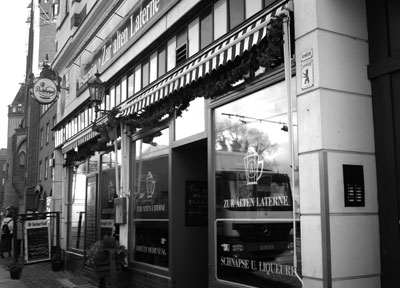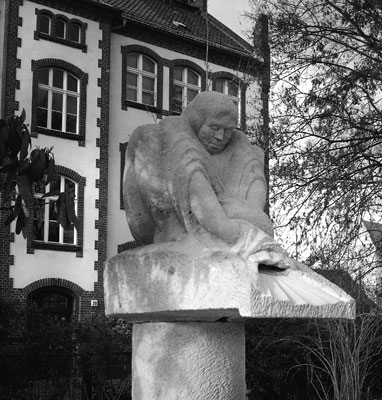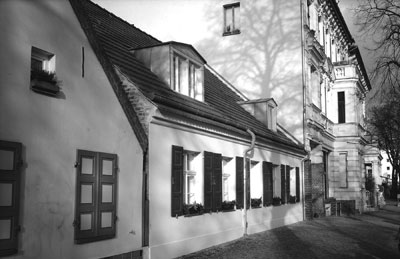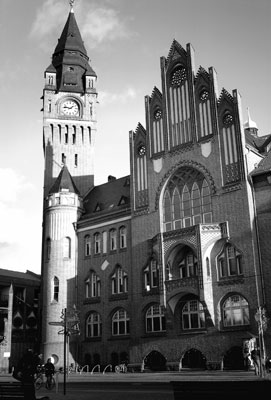Beyond Berlin's city center — a visit to the Treptow-Köpenick district
by Lynn Remly, Arlington, VA
Since The Wall came tumbling down, visitors to Berlin have flocked to the east side to see what was hidden or forbidden for 40 years. Unfortunately, few people travel beyond the city center and its monuments to see what Berlin is all about.
The municipal district of Treptow-Köpenick in the southeastern part of Berlin, not that far beyond the city center, recalls the days of Soviet occupation, but it also shows where today’s Berlin came from and where it’s going.
Establishing a base
I studied at the Free University of Berlin in 1965-66 and return to the city every year to see what’s new and to explore places that were either difficult or impossible to get to while the city was divided. Though foreigners could go to East Berlin for a concert or a day at the museums, everyone had to be back in the West before midnight… or else. (I never asked what the “else” was; I just got back on time.) Today, going back and forth is amazingly convenient.
I always stay at the Atel Hotel Comet (175 Kurfürstendamm, www. hotelcomet.de), located right on the city’s principal shopping and browsing boulevard, which offers many restaurants, bars and shops to add to the sightseeing. The hotel offers small but clean rooms with private facilities (€45-€95 single or €55-€125 double) and an amazing breakfast.
The Comet is within easy walking distance of both the Savignyplatz S‑Bahn station and the Adenauerplatz U-Bahn station, and a bus to Bahnhof Zoo runs right outside. Berlin’s excellent transportation network, accessible by means of single-trip tickets, day passes or week passes, puts the entire city at your feet.
Enticing landscapes
The Treptow-Köpenick quarter holds a lot of history, reaching back to the time when its two parts were independent towns. In addition, three-quarters of its area is covered by water, woods or parkland, giving rise to its historic role as a refuge from city stress. It’s all a part of Berlin now, but the history and the relaxing atmosphere are still there.
Old Treptow started as a fishing village. Its inhabitants also kept bees, brewed beer and offered a restful break to folks from the central city. The 570-acre Treptower Park (S-Bahn station Treptower Park or Plänterwald) and the adjoining Plänterwald (plant forest) were established as an English garden in 1876-88, and miles of walking trails cut through the park or run along the Spree River, which forms a natural harbor.
The harbor is home to the Stern und Kreisschiffahrt (Star and Circle Cruise, Puschkinallee 15; www. sternundkreis.de) company, which, among others, runs boat tours and dinner cruises through the rivers, canals and lakes of greater Berlin. Cruises operate mainly in summer, though a few boats run through the winter as well.
These tours are well worth the modest cost (averaging €15-€20, or $24-$32), giving visitors a chance to see what Berlin’s history is all about: water. Not only has the river system provided food and transportation since the Stone Age, it also has given the city access to markets throughout Europe, both East and West. This watery landscape creates a luminous atmosphere, with reflections everywhere of light on water.
Commemorating the past
The central feature of Treptower Park is its Soviet War Memorial, constructed in 1947-49 in memory of the Soviet troops who died in the Battle of Berlin in 1945. Friends living in East Berlin took me there for the first time in 1965, and I recall being overwhelmed by the size of the monument, around which over 5,000 soldiers are buried.
The memorial is 550 yards long, with two parallel sets of war scenes carved in stone (there is explanatory text in Russian on one side and in German on the other) leading to the huge figure of a Soviet soldier, almost 40 feet high. He carries a sword, with which the army conquered the Nazis, and holds a child, for whom the Soviet sacrifice was made.
In the domed chamber under the statue are mosaics showing mourners from the various Soviet republics. With deliberate irony, the Soviets constructed the memorial using Swedish granite that the Nazis had intended for a triumphal arch to memorialize their own final victory.
Just to the east, Old Köpenick offers a real dip into the city’s past. The town is reachable by the No. 3 S-Bahn line, which begins at the new Hauptbahnhof (main train station), a state-of-the-art facility filled with shops and small eateries and offering local, regional and long-haul train service, both domestic and international.
On the water
Köpenick, which will celebrate its 800th birthday in 2009, started as a Slavic settlement on the Spree and Dahme rivers, dotted with numerous islands. In fact, the name is of Slavic origin and means “island place.”
Exiting the S-Bahn station, a walk south along Bahnhofstrasse leads past shops and the Forum, a shopping center that’s well worth a stop. Farther on, swans in the town park glide over for handouts, and visitors get their first clear impression of the connection between the town and water on seeing the low houses clustered along the water, each with a small boat out front — reminders of the fishing settlement and the trade routes that gave Berlin its start in the 13th century.
The town was so intimately connected to the water that it was, in fact, the laundry for the city of Berlin. That is, citizens from the west sent their clothes to be washed in the Dahme and Spree rivers in the first half of the 19th century, when 200 small and medium-sized laundries operated in the area. A small, privately managed laundry museum, Wäscherei-Museum (Luisenstrasse 23), invokes memories from that time.
Local history
Suddenly, the majestic Town Hall, built 1901-04 in the red-brick style characteristic of the Brandenburg region, loomed up ahead, topped by a 160-foot-high tower and “guarded“ by a life-size bronze statue of the Hauptmann von Köpenick (Captain of Köpenick).
This memorial to Wilhelm Voigt, a shoemaker who stage-managed a takeover of the Town Hall, the capture of the mayor and a robbery of the treasury in 1906, is equally a memorial to chutzpah.
Although arrested and convicted of various crimes, Voigt was pardoned by Kaiser Wilhelm II himself, and the whole story, taken to be a great national joke, was immortalized in Carl Zuckmayer’s play “Der Hauptmann von Köpenick.” Today, the events of the takeover are reenacted by actor Jürgen Hilbrecht in a music show called “The Captain and His World,” which takes place in the basement of the town hall, the Ratskeller, which also hosts other performances, such as the summer Jazz in Town. (For more information, visit www.berlin-tourismus-online. de.)
Castle complex
Finally, I came to the island that offered the original inhabitants of Köpenick safe harbor and a naturally fortified position, today’s Schlossinsel (Castle Island). On the site of the early fortifications and a later Renaissance hunting castle, Prussian King Friedrich I constructed between 1680 und 1690 the only complete Baroque castle in Berlin-Brandenburg.
This lovely building is now the Museum of Decorative Arts, whose permanent collection is supplemented by frequent temporary exhibits. Twenty-one rooms display everything from historic wallpapers to laquered cabinets and silver table services. Tickets cost €4 ($6), or €2 for seniors and students, and the museum is open 10 to 6 Tuesday through Sunday.
In addition, the castle complex (Tiergartenstraße 6; www.smb.spk-berlin.de) includes a Baroque chapel with a hall for public concerts and events. The castle park offers lovely views of the Dahme River and the houses along the water.
A café overlooking the water is a good place for a snack or a full meal, but remember that Berlin only recently banned smoking in public places, so the open-air section might be preferable for nonsmokers.
Just across the bridge to the east is, incidentally, a statue of a washerwoman — a reminder that the past is always with us, no matter how humble.
My favorite activity in this area is walking through the Kietz, just to the east of the Schlossinsel. This tiny settlement was mentioned as a Slavic fishing village as early as 1375 and remained an independent village until 1898. The quaint, low houses along the main street are reminders of the early days, as is the town’s coat of arms, which features two silver fish against a blue field.
You can sit on a bench overlooking the Dahme River and let your mind wander back to the distant past, when the water provided everyone a living.
Fine food
Finding a meal is no problem anywhere in Berlin, but Köpenick offers a very wide range of possibilities. The food court in the Forum is like all food courts, offering everything from coffee and a snack to full meals from various fast-food outlets.
The Ratskeller, of course, features traditional German food in a traditional setting, as do the nearby Altstadtcafé Cöpenick (Alt-Köpenick 16; phone 030 655 7297) and Zur alten Laterne (Alt-Köpenick 33; phone 030 655 7297).
You may want to try a Berliner Weisse, a drink of wheat beer with a shot of either raspberry or woodruff syrup. It sounds like an acquired taste, and it is, but it’s certainly the local drink.
For Bavarian cuisine served right on the water, try the Waschhaus Alt Köpenick (Katzengraben 19; phone 030 65 498319 or visit [in German only] www.waschhausaltkoepenick.
de).
If you go hungry or thirsty in Köpenick, it’s your own fault.
After seeing the Brandenburg Gate, Potsdamer Platz, Unter den Linden, the cathedral and the other wonderful monuments that make Berlin a world-class city, try venturing a bit deeper into the east — and into the past — to see what the city is really all about. You might like it.

